From Pasture to Plate: The Story of Alpine Cheeses and How to Choose the Best Ones
Are you a cheese lover? Well, if you are, you’re in for a treat! Let’s talk about the famous and refined mountain cheese that is crafted using ancestral traditions. It’s a product of exceptional milk produced by cows grazing in the alpine meadows, where the food they consume is particularly rich. Sports-Hiver.com has decided to explore more about the Alpine cheeses, and we’ve got a fun and informative rundown of the many specialties, along with some tips and tricks to ensure that you get the most authentic and high-quality products.
According to a 2007 decree, “cheese” is defined as “a fermented milk product obtained by coagulating cream, milk, or a mixture of both, followed by draining.” Did you know that the French are the biggest cheese consumers in the world, with an average of 24 kilos of cheese per person per year? They’re only second to the Greeks, who consume 25.4 kilos of cheese annually! In 2004, France and Germany were the world’s two largest cheese exporters.
Today, more and more consumers are becoming wary of industrial products and are opting for more authentic, locally-sourced products. Unfortunately, official labels that certify authenticity and quality don’t yet have enough visibility and recognition. That’s why Sports-Hiver.com is here to help you understand the labels and characteristics that guarantee the quality of a selection of French, Swiss, and Italian Alpine cheeses.
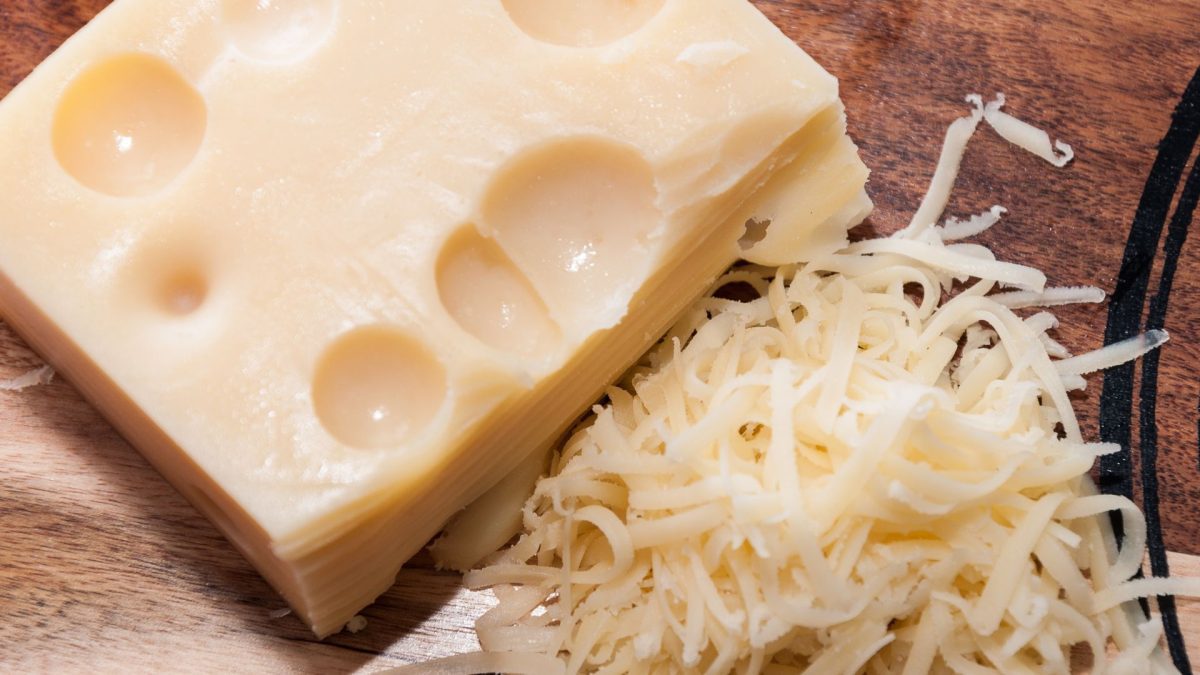
So, are you ready to explore the world of Alpine cheeses and discover their unique flavours and traditions?
Here are some quick tips for recognising the production conditions and taste qualities of a cheese:
Dry extract, fat content, and milk origin are mandatory characteristics to be mentioned on the label,
The “made from raw milk” (lait cru) label can only be used if the milk has never been heated above 40°C. This guarantees a much more distinct flavour compared to cheeses made from pasteurized milk,
The “farmhouse cheese” label indicates that the cheese was made from milk produced on the farm where it comes from,
Today, to recognise quality by all European consumers, the E.U.’s PDO (Protected Designation of Origin) replaces the national AOC (Controlled Designation of Origin). It assures consumers of the quality and adds value to the product. Today, all PDOs can be identified by the PDO label on the packaging.
Over 180 European cheeses, creams, and butter benefit from the PDO label, including 49 from France.
PDO is a genuine guarantee of quality but lacks visibility: only 13% of cheeses consumed in France today are PDOs.

when we say “Reblochon,” we have to say “tartiflette”!
Reblochon cheese was born from a clever scheme by farmers to pay fewer taxes. Its name comes from the Savoyard term “re-blocher,” which in the 16th century meant “to milk again,” but the practice dates back to the 13th century. According to tradition, the farmers in the massif would milk the cows twice, once for the owner (usually abbeys) and once more for themselves at night, to avoid paying high taxes based on the quantity of milk produced. This second milking, though less abundant, was richer in cream and had a higher fat content, making it of superior quality.
Reblochon is the third most produced AOC cheese and has held this label since 1958.
When choosing your Reblochon, be careful. In 2006, reblochon producers spoke out against the commercialization of “tartiflette cheese” in supermarkets (4,000 tons sold per year). This cheese is not true reblochon; it is designed specifically to be melted and, despite its mediocre quality, is sold for barely less than the real thing. It’s best to choose “farmhouse reblochon” or, at the very least, “fruitier” reblochon, but avoid “dairy reblochon.”
Of course, when we say “Reblochon,” we have to say “tartiflette”! Tartiflette is a modern dish inspired by a traditional dish called “pela,” which in Savoyard dialect refers to a pan with a long handle in which the dish was prepared. The word “tartiflette” comes from the Savoyard dialect, from the word “tartifla” which means “potato.” Its recipe was developed by the Interprofessional Syndicate of Reblochon in the 1980s to boost sales of this cheese. There are several variations, especially since the presence of onions is not unanimously agreed upon.

Practical information on Reblochon cheese:
Wine pairing: Gamay
Average price: 9 to 15 euros per kilogram depending on the ripeness
The Prince of Gruyères: Discovering the Unique Beaufort Cheese of Savoie
Beaufort cheese, a member of the Gruyère family, is considered “the prince of Gruyères” due to its flavourful taste (with a hint of hazelnut) and high quality. Unlike most pressed-cooked cheeses, Beaufort doesn’t have any holes.
Its characteristic concave heel is a result of the traditional method of Beaufort cheese-making. After the milk is coagulated in a copper pot, the cheese is moulded in a linen cloth and placed in a beechwood circle. A Beaufort wheel can weigh between 20 and 70 kilos.
When choosing Beaufort cheese, the summer Beaufort is better than winter Beaufort, which has less flavour and is often used as an ingredient in fondues.
However, among “summer Beauforts,” you should look for the “chalet d’alpage” label. Made immediately after milking in an alpine chalet located above 1500 meters and according to traditional methods, it has a very fatty, yellow paste full of flavours.

Practical information about Beaufort cheese:
Wine pairings: Chablis, Apremont or Chignin
Average price: 18 to 20 euros per kilo
Abondance Cheese: A Name Full of Promise and Rich History
The name “Abondance” refers to a village, a canton, an alpine valley, a bovine breed, and finally… a cheese, produced in the Pays d’Abondance in the Chablais region of Haute-Savoie. It’s a semi-hard, pressed cheese similar to Beaufort, but a bit milder. It also has the concave shape due to the circular binding. It must then be aged for at least three months in a cheese cave on spruce planks, which help regulate humidity.
Abondance cheese was born in the 12th century
At that time, the canons of the Abbey of Abondance began clearing the valley to create pastures and promote agriculture. It’s in these pastures, rich in floral and aromatic flavours, that the methods for producing Abondance cheese were developed. This delicacy was highly appreciated at the Savoy and Versailles courts, with even Louis XIV being fond of it!
When choosing Abondance cheese, the older it is, the stronger and more flavorful it becomes. You can enjoy either farmhouse Abondance cheese, which its oval can recognize, blue casein plaque, or dairy Abondance cheese, identifiable by its square, blue casein plaque. Farmhouse Abondance is made in the alpine pastures, while dairy Abondance is made in fruitières or cooperatives.
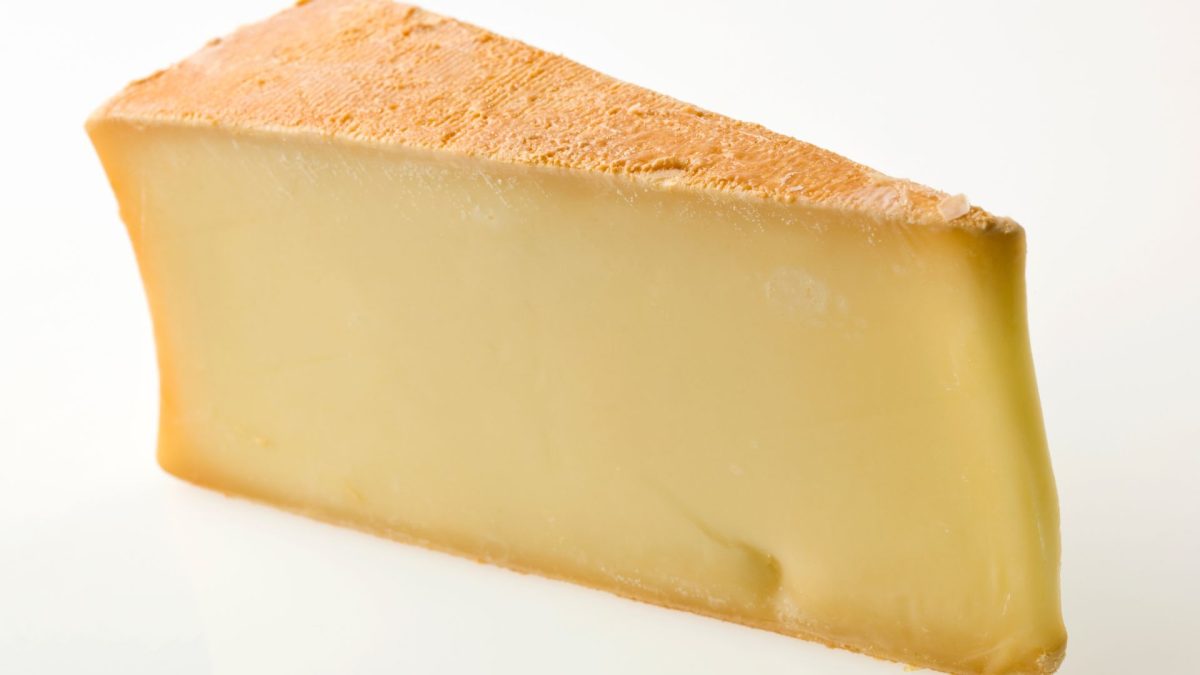
When choosing Abondance cheese, the older it is, the stronger and more flavorful it becomes. You can enjoy either farmhouse Abondance cheese, which its oval can recognize, blue casein plaque, or dairy Abondance cheese, identifiable by its square, blue casein plaque. Farmhouse Abondance is made in the alpine pastures, while dairy Abondance is made in fruitières or cooperatives.
Practical information about Abondance cheese:
Wine pairings: Crépy, Marignan, Marin, Ripaille
Average price: 20 euros per kilo
Discover the True Origin of Emmental Cheese: It’s Swiss!
Contrary to popular belief, Emmental cheese is actually a cheese that comes from the Emme Valley in the east of the canton of Bern in Switzerland. Today, it’s produced in many European countries, including France. The total European production amounts to 460,000 tons per year.
Emmental or Gruyere?
In France, Emmental cheese was often mistakenly called “Gruyere.” Emmental and Gruyere are both pressed cheese with cooked paste. With its firm and flexible texture, Emmental cheese is distinguished by its regular holes, poetically called “eyes,” usually about the size of a walnut.
Practical information about Emmental cheese:
Wine pairings: Bordeaux, Côtes de Provence, Côtes du Rhône
Average price: 12 euros per kilo
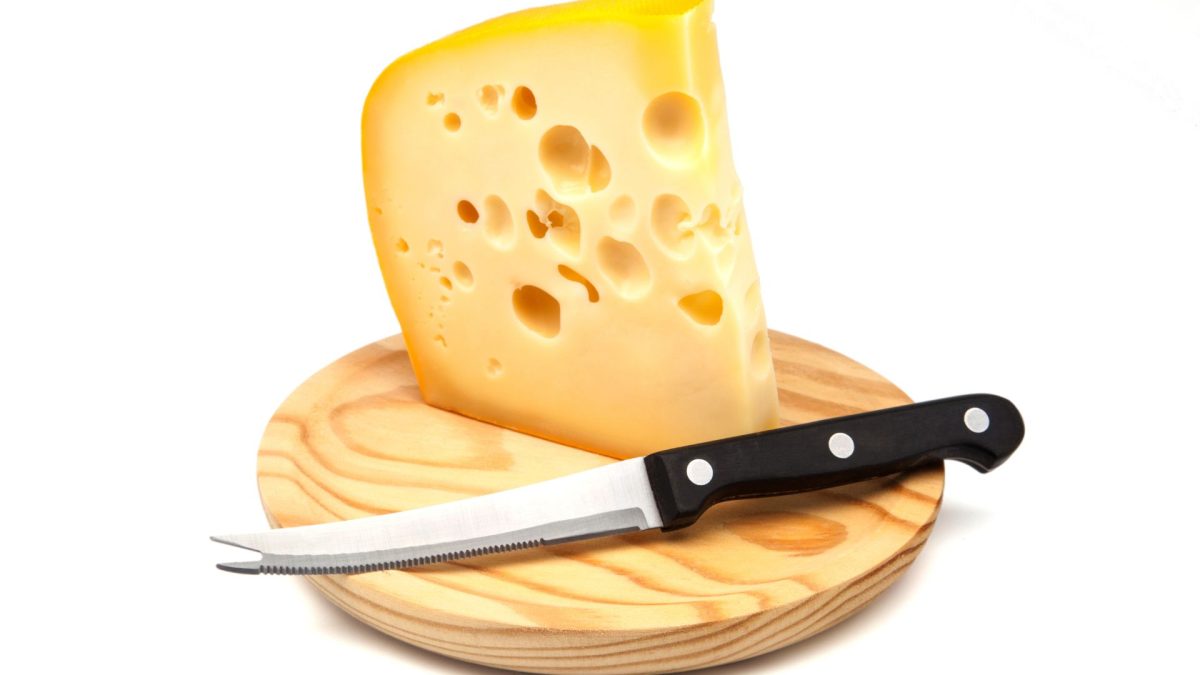
Choosing the right Emmental cheese
In 1981, French Emmental producers signed an agreement that led to the creation of the “grand cru” Emmental red label, exclusively reserved for cheeses made from raw milk and aged in the east of France. The “Savoie” label indicates that the Emmental cheese was made in Savoy or Haute-Savoie for a minimum aging period of 75 days. Finally, due to the increasing development of low-cost substitute products, cheese makers have wanted to impose a “certificate of conformity” to attest that their product is indeed French Emmental cheese that has been aged properly.
Don’t forget the “Persillés” cheeses of the French Alps
The Persillé des Aravis
This small cylindrical cheese is made from raw and whole milk. Its paste is unpressed, cooked, and of course, marbled with blue veins.
It is almost extinct today, but the Persillé de la Clusaz, located a few kilometers from the Aravis valley where it was originally made, has similar characteristics.
The rind is hard and gray, with white and orange molds. It is best consumed when fully aged.
It is typically eaten during Christmas.
The Persillé de Tignes
According to tradition, this cheese was already appreciated during the time of Charlemagne and served on his table.
In 1875, it was made from half goat’s milk, a quarter sheep’s milk, and a quarter cow’s milk cream. It is also called Persillé de Haute Tarentaise.
Today, it is mainly produced in Sainte Foy Tarentaise, and goat’s milk is sometimes mixed with cow’s or sheep’s milk.
It is a high-quality, rare, and rustic farmhouse cheese.
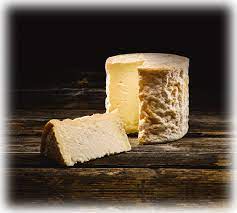
Practical Information about Persillés
Wine pairing: Mondeuse de Savoie.
Average price: 32 euros per kilogram.
Swiss or french? Where is Gruyère really from?
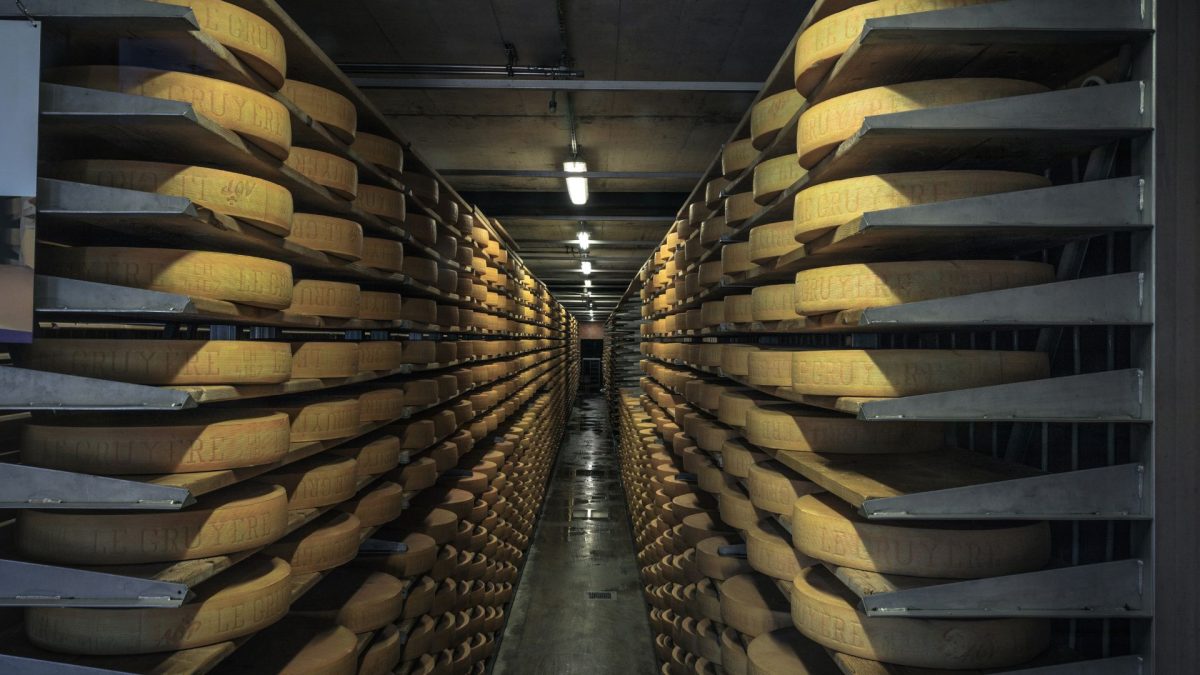
Practical Information about Gruyère Cheese:
Wine Pairings:
Young Gruyère cheese (4 to 6 months of aging): Jura Chardonnay, Charcennes country wine, or Savoie wine. It can also be enjoyed with a cold blonde beer or cider.
More aged Gruyère cheese (6 to 12 months of aging): White wine from the Jura, Trousseau from the Jura, Mondeuse from Savoie, Roussette from Savoie, or Pinot from Burgundy. It can also be enjoyed with a red or brown beer.
Average price of French Gruyère cheese: between 12 and 15 euros per kilo Average price of Swiss Gruyère cheese: from 15 to 27 euros per kilo, depending on the aging.
Gruyère: Origin of the Word
Gruyère cheese gets its name from the Gruyère district in the Canton of Fribourg and the village of Gruyères in Switzerland, which themselves are named after the “gruyer.” During the time of Charlemagne, this word referred to an officer in charge of collecting taxes for the administration of finances. In 1762, the French Academy added the word “gruyère” to its dictionary, specifying that it is a cheese from the Gruyère region.
Is Gruyère a French or Swiss Cheese?
In 1951, the International Convention on Cheeses in Stresa recognized that the term “gruyère” is a Franco-Swiss property. Since then, the term “cheeses from the Gruyère family” has been used, which includes Beaufort and Abondance, for example. For centuries, producers on both sides of the Franco-Swiss border have been producing Gruyère, not without disputes over its original origin. Gruyère is also produced in the Jura mountains and north of the Alps in France. The Stresa conference clarified things without making anyone jealous!
Gruyère Cheese: Without Holes or with Small Holes!
Today, Swiss Gruyère cheese, which obtained the Swiss AOC in 2001 (without holes), and French Gruyère cheese, which obtained the valuable AOP in 2007, must be distinguished. The latter has holes whose size varies from that of a small pea to that of a cherry. Swiss AOC Gruyère became the first Swiss AOC cheese in terms of volume in 2009, with 28,000 tons produced in 2008. France, on the other hand, produced 1,600 tons the same year.
The Montassio, an Italian Alpine cheese
Origin of Montasio cheese
- Montasio cheese is named after the Montasio massif and was first produced in the Julian and Carnic Alps in the Friuli region of Italy around 1200 AD.
- It was originally made with sheep’s milk by Benedictine monks and became popular throughout northern Italy by the 17th century.
- Montasio cheese was granted PDO (Protected Designation of Origin) status in 1996.
Types of Montasio Cheese
- Montasio cheese is available in three aging categories: “fresco” (fresh, aged for two months), “mezzano” (semi-aged, aged for five to ten months), and “stagionato” (aged, aged for over ten months).
- Extra-aged Montasio cheese can be used grated or in chunks.
- There is also a type of Montasio cheese called “ivre,” which is aged by soaking it in wine lees. This gives the cheese a purple rind and a firmer texture.
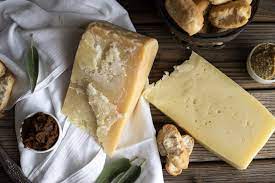
Nutritional Information and Culinary Uses
- Montasio cheese is a balanced cheese with 32-34% fat and 24-26% protein. It is rich in calcium and vitamin E.
- It is typically served as a table cheese, often dipped or fried in olive oil, but it can also be used in many local specialties.
- Montasio cheese is often melted and served as a sauce to accompany meat or fish dishes. To make a creamy and homogeneous sauce, melt diced mezzano Montasio cheese slowly, adding a few tablespoons of béchamel sauce and a pinch of nutmeg.
- Stagionato Montasio cheese is often served in shavings at the end of a meal.
Wine Pairings
- Montasio fresco pairs well with aromatic wines such as Traminer, as well as dry and fragrant wines like Pinot Blanc, Sauvignon, or Chardonnay.
- Montasio mezzano pairs well with Tocai Friulano and Merlot.
- Montasio stagionato pairs well with full-bodied red wines such as Cabernet Franc, Raboso Del Piave, Verduzzo Trevigiano, and Picolit.
Price
- The average price of Montasio cheese is between 18 and 25 euros per kilogram, depending on the aging.

